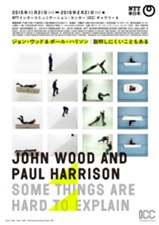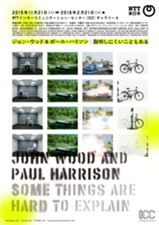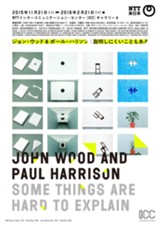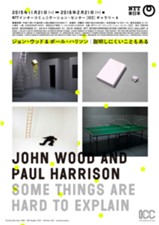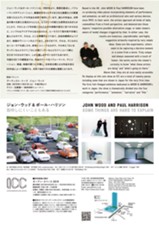Preface
Based in the UK, John WOOD and Paul HARRISON have been co-producing video pieces incorporating elements of performance and animation, as well as architectural sets and various devices, since 1993. In their work, the artists approach all kinds of daily commodities from a fresh perspective, and demonstrate those objects’ respective possible alternative usage, or make viewers aware of modal changes triggered by that. In either case, the results are humorous, unpredictable, and highly suggestive artworks inspired by very simple ideas. Some are like experiments, others seem to be capturing a decisive moment or a scene from a movie. Truly unique and always seasoned with a touch of humor, the works excite the viewer’s curiosity to know “what these artists are doing” and “what’s going on there.” Above that, they are at once easily accessible.In recent years, large-scale exhibitions have been held in and outside the UK, while in Japan the works of WOOD and HARRISON were introduced in the NHK Educational TV program “2355,” as well as in exhibition at Mori Art Museum and a travelling exhibition organized by the British Council. Six of their works enjoyed high popularity with the audience when exhibited at ICC’s “Open Space 2012” exhibition.
On display at ICC this solo show are a total of twenty pieces including some that are shown in Japan for the very first time. The first full-fledged exhibition dedicated to WOOD and HARRISON’s work in Japan, the show is thematically divided into the four categories “performance,” “animation,” “narrative” and “film.”
On the exhibition
WOOD and HARRISON, John and Paul... Well this isn’t about famous rock bands, but John WOOD and Paul HARRISON are two British artists operating in the field of contemporary art. Together they create moving images. Depicted in these videos are the artists themselves executing certain ideas in a straightforward, expressionless manner (yet sometimes obviously suppressing laughter); exquisitely timed, “decisive moment” sort of unlikely likely happenings staged with various mechanisms and devices; mechanical animations and automated processes that are all inorganic yet somehow charged with a sense of warmth; human characters doing different things in the same setting that appears again and again as the “camera” scrolls down; spectacular movie scene kinds of actions reconstructed in miniature sets, and suchlike. Some are funny and make the viewer chuckle, others astonish, while sometimes prompting the viewer to keep staring at the screen quite earnestly. Outlined in the details are laws of nature in effect during everyday occurrences, or the properties of physical matter, here and there spiced up with elements of comedy, drama, literature, contemporary art or cinema. The common thread that runs through all these works is an expression of occurrences as part of reality. This means that all those brief moments captured in their works (even the longer pieces are made up of multiple short sequences), those startling happenings, are unmistakably things that actually happen in front of the camera. The camera is a medium for recording the artists’ experiments conducted using objects or their own bodies, whereas the resulting works capture that one particular moment, that singular event that happened to happen there. Although different from how media art (or technology) apparently performs miracles in scientific/technical ways, they can be considered as highly suggestive demonstrations of ways of realizing odd ideas, and amazing audiences by doing things that seem rather impossible to do.The title “Some Things Are Hard to Explain” reflects the artists’ awareness of the fact that some aspects necessarily get lost when translating ideas into certain means of artistic expression, just like one cannot precisely and completely translate imagery into text, or explain a text in different words. Being “experimental” supposedly means that “the result is unpredictable,” or in other words, that things don’t necessarily go as expected, which is why that one singular event begins to appear like a miracle, something that wasn’t supposed to be possible. For this reason, the works that emerge in such ways from the artists’ various experiments are perhaps just as “hard to explain”...
HATANAKA Minoru/Chief Curator, ICC

